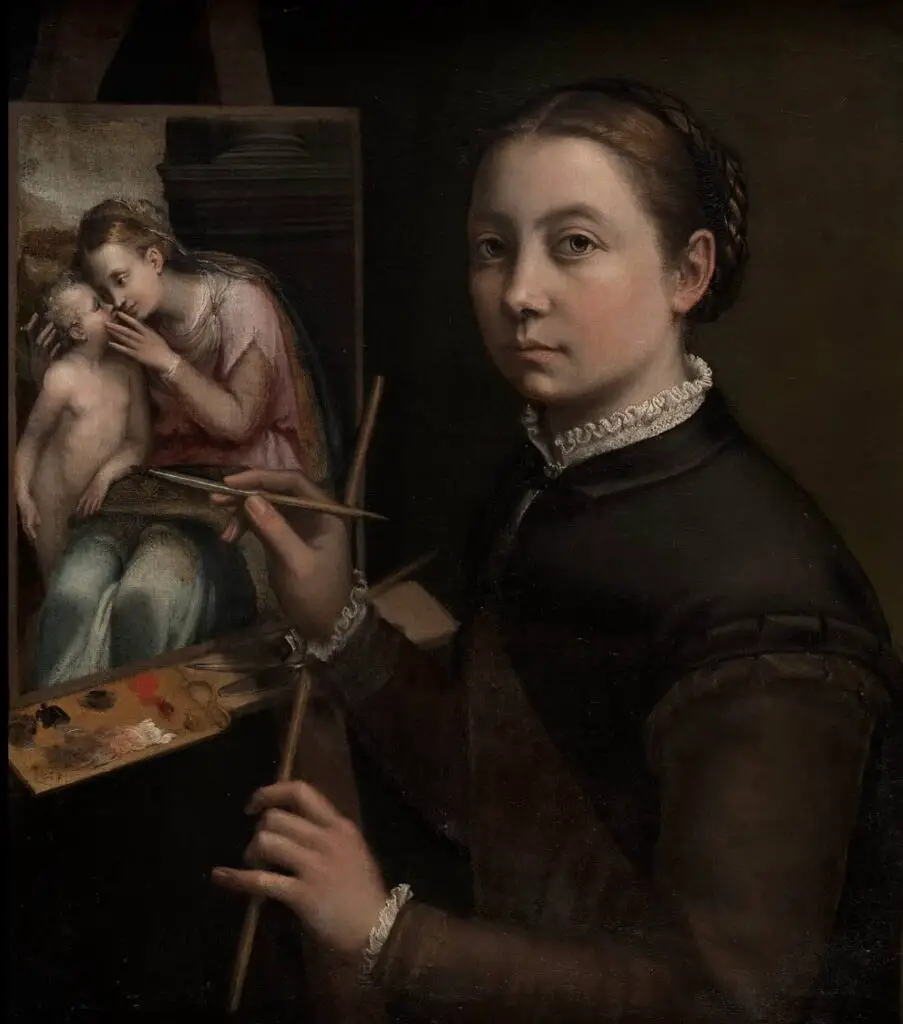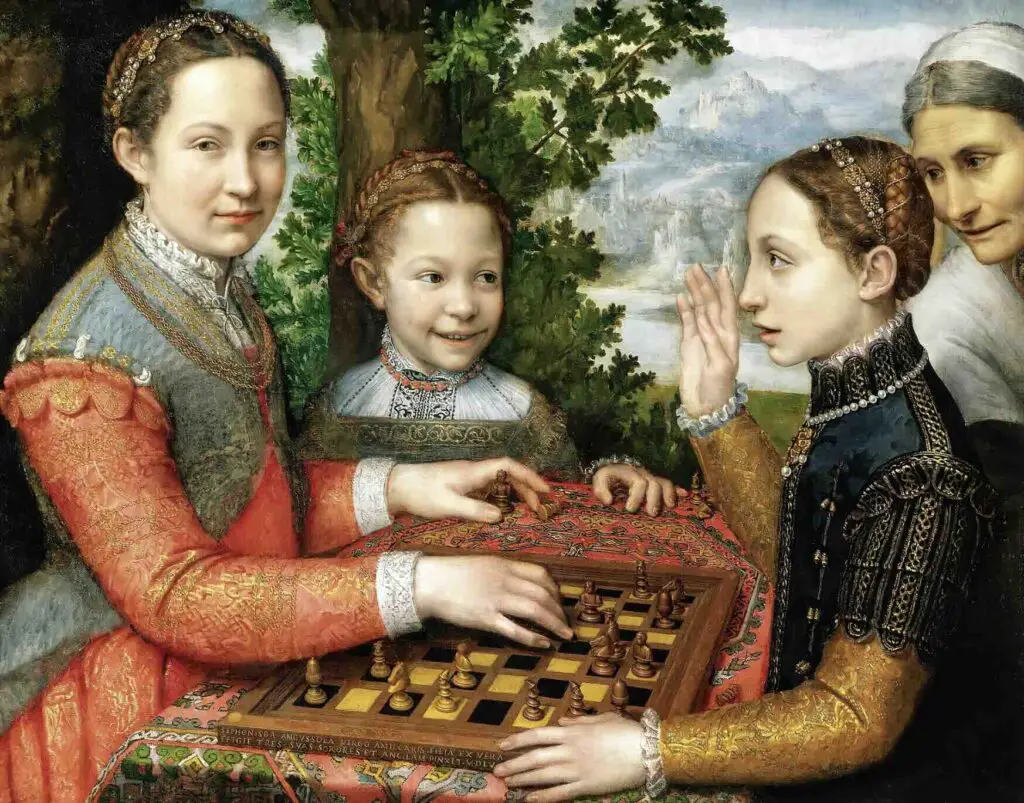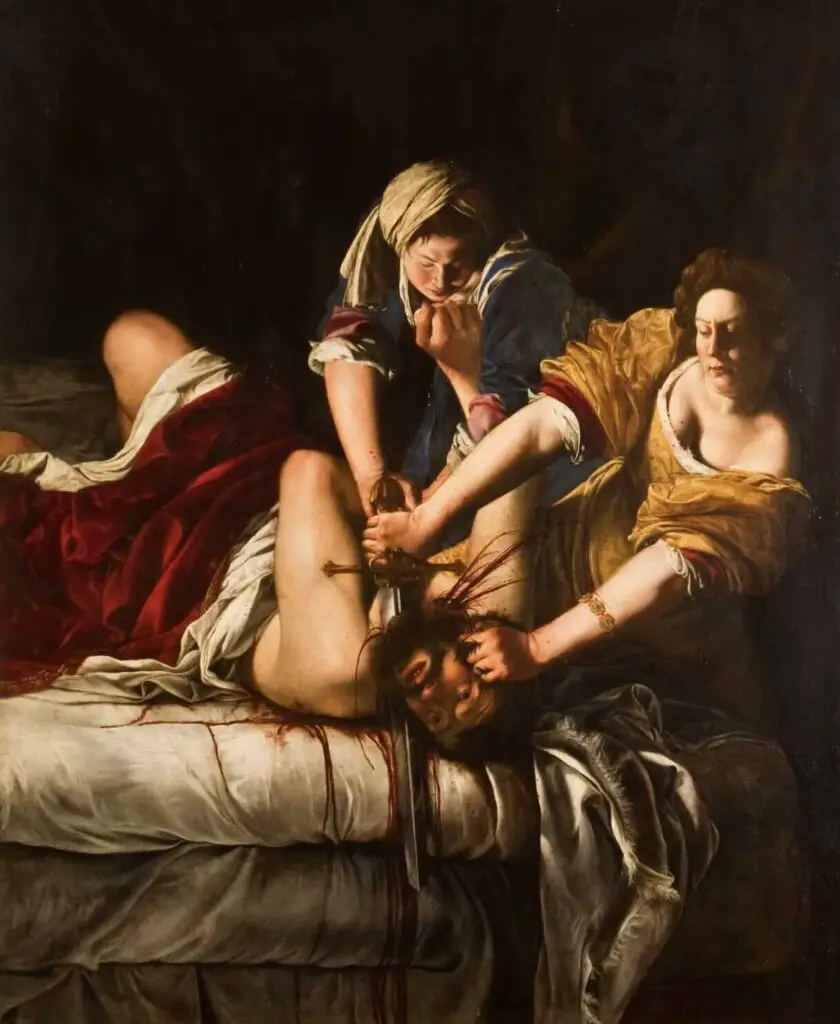Art history has often been written from a male-dominated perspective, overshadowing the contributions of many talented female artists.
Despite systemic barriers, these women artists profoundly impacted the art world, creating works that rivaled but often surpassed those of their male counterparts. This post celebrates some of the most influential female artists from the Renaissance to contemporary times, highlighting their lives, struggles, and the enduring legacies of their work.
Table of Contents
- Sofonisba Anguissola (1532–1625)
- Artemisia Gentileschi (1593–1656)
- Mary Cassatt (1844–1926)
- Georgia O’Keeffe (1887–1986)
- Frida Kahlo (1907–1954)
- Yayoi Kusama (1929–Present)
- Louise Bourgeois (1911–2010)
- Faith Ringgold (1930–Present)
- Celebrating the Legacy of Female Artists
- Related Questions
Sofonisba Anguissola (1532–1625)

Breaking Ground in the Renaissance
Sofonisba Anguissola was a trailblazer of her time and one of the first known female artists to achieve international recognition. Born in Cremona, Italy, Sofonisba came from a noble family that recognized and nurtured her talent early on. Unlike many women of her era, who were discouraged or forbidden from pursuing art as a profession, she received formal training under the tutelage of local painters.
Contributions and Style
Sofonisba’s work focused on portraits, and her style was marked by a keen attention to detail and an ability to convey the sitter’s personality and emotions. One of her most famous works, The Chess Game, depicts her sisters in a relaxed and playful moment, showcasing her skill in capturing familial intimacy and fine details.

Her success garnered the attention of the Spanish court, where she became a court painter for King Philip II. This appointment broke barriers for female artists, demonstrating that women could hold significant positions in art.
Artemisia Gentileschi (1593–1656)

Triumph Over Adversity
Artemisia Gentileschi is often heralded as one of the most influential painters of the Baroque period. She was the daughter of Orazio Gentileschi, an accomplished painter, who introduced her to the craft.
Artemisia’s path was fraught with challenges; at 17, she survived a traumatic experience of sexual assault by her tutor, Agostino Tassi, and endured a highly publicized trial that scandalized Rome.
Masterpieces and Feminist Symbolism
Despite these personal hardships, Artemisia channeled her pain and strength into her art, creating pieces that resonated with female empowerment and resilience themes. One of her most famous works, Judith Slaying Holofernes, depicts the biblical heroine Judith beheading Holofernes with striking realism and intensity.

The painting stands out for its dramatic use of chiaroscuro and emotional power, embodying Artemisia’s defiant spirit and mastery of Baroque techniques. Her work has inspired generations of women and continues symbolizing strength and perseverance.
Mary Cassatt (1844–1926)

The American Impressionist
Mary Cassatt was an American painter who became a prominent figure in the Impressionist movement in France, making significant strides in a male-dominated art scene. Born into a wealthy family in Pennsylvania,
Cassatt studied at the Pennsylvania Academy of the Fine Arts but felt limited by its conservative approach. She moved to Paris to study and immerse herself in the vibrant art world of Europe.
Themes of Motherhood and Domestic Life
Cassatt’s work often focused on the intimate world of women, especially the bond between mothers and children. Her paintings, such as The Child’s Bath, capture tender moments with bold colors and loose brushwork characteristic of the Impressionist style.

Her perspective offered a unique view of domestic life, challenging traditional representations of women by depicting them as active, compassionate, and thoughtful individuals. Cassatt’s legacy as one of the few female Impressionists continues to inspire artists interested in exploring themes of womanhood and family.
Georgia O’Keeffe (1887–1986)

The Mother of American Modernism
Georgia O’Keeffe is celebrated as the “Mother of American Modernism.” Born in Sun Prairie, Wisconsin, O’Keeffe’s early exposure to art led her to pursue formal education at the Art Institute of Chicago and the Art Students League of New York. Dissatisfied with the traditional art education of her time, O’Keeffe developed her unique style that emphasized abstract shapes, vibrant colors, and bold compositions.
Iconic Works and Legacy
O’Keeffe is best known for her large-scale paintings of flowers, such as Jimson Weed/White Flower No. 1, and her stunning depictions of the New Mexico landscape. Her work often drew interpretations that linked her flowers’ sensual, organic shapes to the female form, a notion she neither confirmed nor denied, preferring to let viewers engage with the art on their terms.

O’Keeffe’s pioneering spirit and dedication to a distinct voice in modern art paved the way for future generations of female artists.
Frida Kahlo (1907–1954)

A Life of Pain and Passion
Frida Kahlo’s life was marked by physical suffering and emotional turbulence, which profoundly influenced her art. Born in Coyoacán, Mexico, Kahlo contracted polio at a young age and was later involved in a tragic bus accident that left her with lifelong medical complications.
Despite these hardships, Kahlo channeled her pain into vivid, surreal self-portraits that explored identity, the body, and the experience of womanhood.
Surrealism and Symbolism
Kahlo’s paintings are rich in symbolism and personal narrative. Works such as The Two Fridas and Self-Portrait with Thorn Necklace and Hummingbird blend surreal imagery with raw emotion, challenging societal norms and traditional representations of women.

Kahlo’s art is infused with Mexican culture, folklore, and political themes, making her not only an icon of feminist art but also a symbol of Mexican identity. Her legacy lives on as a testament to resilience, creativity, and the power of self-expression.
Yayoi Kusama (1929–Present)

The Avant-Garde Visionary
Yayoi Kusama, born in Matsumoto, Japan, is one of our most influential contemporary artists. Known for her obsessive use of polka dots and repetition, Kusama’s work spans various media, including painting, sculpture, performance art, and installations.
Her journey has been marked by struggle as she has battled mental health issues throughout her life. Kusama’s art is both a reflection of her inner world and an invitation for viewers to immerse themselves in infinity and abstraction.
Immersive Installations and Global Influence
Kusama’s Infinity Mirror Rooms are among her most celebrated works. They captivatingly reflect audiences with their boundless reflections and the illusion of infinite space. Her installations are renowned for creating immersive experiences that blur the line between art and environment, drawing viewers into a shared exploration of space and perception.

Kusama’s unapologetic approach to self-expression and influence on contemporary art has solidified her status as a trailblazer in modern art.
Louise Bourgeois (1911–2010)

Sculptor of Emotions
French-American artist Louise Bourgeois is best known for her powerful sculptures, which explore themes of trauma, memory, and femininity.
Born in Paris and later moving to New York City, Bourgeois was heavily influenced by her childhood experiences, particularly her complex relationship with her parents. These emotional underpinnings became the driving force behind her work.
Iconic Works and Themes

Bourgeois’ most famous piece, Maman, is a giant spider sculpture over 30 feet tall. The spider, representing her mother, embodies themes of protection, strength, and the complexity of maternal relationships.
Her art, often raw and deeply personal, challenged conventional notions of form and subject matter, paving the way for future artists to use their experiences as powerful sources of inspiration.
Faith Ringgold (1930–Present)

A Voice for Social Justice
Faith Ringgold is an African American artist and writer whose work focuses on themes of race, gender, and social justice. Born in Harlem, New York, during the Harlem Renaissance, Ringgold was influenced by the vibrant cultural environment of her upbringing.
She initially trained as a painter but later expanded her practice to include mixed-media work, quilting, and children’s books.
Story Quilts and Narrative Art
Ringgold’s story quilts, such as Tar Beach, combine painting and quilting to tell stories about African American life, history, and identity. These quilts blend visual art with written narrative, creating multidimensional works highlighting personal and collective experiences.

Ringgold’s art challenges societal norms and gives voice to those often marginalized, making her a pivotal figure in the fight for equality and representation in art.
Celebrating the Legacy of Female Artists
From Sofonisba Anguissola’s trailblazing work in the Renaissance to contemporary pioneers like Kara Walker and Yayoi Kusama, female artists have continually defied societal expectations to make their mark on the art world.
These women have produced extraordinary art and opened doors for future generations of artists, proving that creativity transcends gender barriers. Their stories remind us that the art world is richer for their contributions and that recognizing their achievements is crucial to understanding the full scope of art history.
By celebrating the accomplishments of these groundbreaking female artists, we honor their resilience, innovation, and the indelible impact they have made on culture and society.
Anita Louise Art is dedicated to art education, great artists, and inspiring others to find and create their art. We love art that uplifts and inspires. #ArtToMakeYouSmile! #ArtToMakeYouHappy!
If you are interested to see any of my art, you can find out more by clicking here. If you are interested in what inspires me and my paintings, you can discover more by clicking here.
We have a free newsletter and would love you to be part of our community; you can subscribe to the newsletter by clicking here. If you have any questions, I would be happy to talk to you at any time. You can reach me, Anita, by clicking here.
Subscribe to our Anita Louise Art YouTube Channel, filled with great videos and information, by clicking here.
Related Questions
Claude Monet And The Rise Of Japonisme
Japan opened its doors to the Western world for trade in 1853, and with that came a flood of Japanese art, artifacts, and textiles to Europe. Many Impressionist artists were fascinated with Japan, but one heavily influenced by Japanese art and the Japanese artist’s technique was Claude Monet.
By clicking here, you can discover more by reading Claude Monet And The Rise Of Japonisme.
Edgar Degas And The Influence Of Japonisme On His Work
Edgar Degas was among the Western artists deeply inspired by this Japanese art form. His works bear a clear imprint of the aesthetics and techniques he absorbed from Japanese Ukiyo-e masters. Read on; we delve into how his exposure to Japanese artistry shaped Degas’s art and examine some of his works that display this definitive influence.
You can discover more by reading Edgar Degas And The Influence Of Japonisme On His Work by clicking here.
Impressionism And The Influence Of Japonisme
The word Japonisme was used to describe the influence of Japanese art on Impressionism art. The Impressionism artists would study Japanese art and then incorporate parts of the Japanese art techniques and inspiration into their art. Japanese art influenced artists like Claude Monet, Vincent Van Gogh, Edouard Manet, Mary Cassatt, Edgar Degas, Paul Gauguin, James McNeill Whistler, and Henri de Toulouse-Lautrec.
By clicking here, you can discover more by reading Impressionism And The Influence Of Japonisme.

